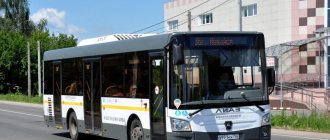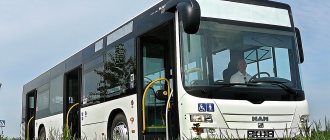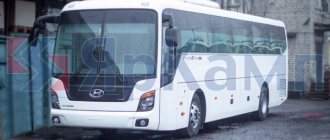What do you need for a bus tour?
During a bus tour, the journey takes a long time. For a trip to be successful and memorable, not only a rich excursion program is important, but also comfortable conditions along the way. Minor details often spoil the impression of a trip. We need to think about what should be on the excursion bus so that tourists have only pleasant impressions from the tour.
What should be on the excursion bus?
A long trip is tiring, so the seats play a special role. The reclining seat back will allow passengers to rest and relax on the road. A separate lamp is installed above each place. It is convenient if each passenger has a personal table on which you can put food for a snack or place drinks.
The climate control system is responsible for creating comfortable conditions in the cabin. It is desirable that the possibility of individual adjustment of temperature and air ventilation be provided.
A bio-toilet and a kitchen in the cabin will reduce the number of stops at cafes and eateries during a multi-day excursion. This will significantly save time spent on the road.
In order for tourists to be able to put things they took with them on the road or bought during excursions, a spacious luggage compartment is necessary.
Microphones and a public address system are required in the cabin so that tourists can hear the announcements of the attendant and the driver.
A separate seat is allocated for the guide. It is convenient when a swivel seat is used so that the guide communicates with passengers while sitting facing them.
Bus classes for tourists
Tourist buses have different levels of interior comfort and additional equipment. Has the meaning:
- interval between seats,
- chair back height,
- the presence of armrests,
- availability of additional amenities: dry closet, kitchenette, refrigerator.
Depending on this, there are 5 classes of buses for tourists:
- 1 star. First class buses practically do not differ in level of comfort from those operating on citywide routes. They have a slightly larger distance between the seats - 68 cm. They are allowed to organize short tourist trips within the city and in the suburbs.
- 2 stars. Second class buses have a greater level of comfort. The distance between the seats is 72 centimeters. They are allowed to make tourist trips over short distances throughout the country and beyond.
- 3 stars are assigned to top class buses. The distance between the seats is at least 77 cm. Starting from 3rd grade, the seats must be equipped with 2 armrests. An individual lamp is installed above each place. The cabin provides additional amenities: a dry closet, a kitchenette with a microwave and a coffee maker. This allows you to make multi-day trips around the country and abroad.
- 4 stars are assigned to a tourist bus equipped with air conditioning. The distance between the seats is at least 83 cm.
- 5 stars are assigned to a tour bus with additional amenities. The distance between the seats is 90 cm. The chairs must have an adjustable headrest and adjustable lumbar support. The cabin has space for a full-fledged kitchen with a microwave, grill, dispenser for hot and cold drinks, and a thermal cabinet where pre-prepared meals are stored. A board is installed for passengers. Its screen displays information about the route, nearest stops, travel time, air temperature, etc.
A certificate of assignment to a bus of a certain class is issued by the International Road Transport Union (IRU). If you are interested in renting a bus from a particular company, ask them for this certificate.
Open Tour bus routes (L'OpenTour)
Blue route
Start: 9.30 Last bus: 17.30 Tour time: 1 hour 45 minutes.
Interval: 15 minutes. Stops
1. Boulevard Haussmann - Paris National Opera - Tourist Information Center, rue Aubert 13 2. Rue 4 September, avenue Opera 49 3. Palais Royal - Comédie Française, avenue Opera 3 4. Louvre, Place Carrousel 5. Orsay Museum, embankment Anatole France 8 6. Place de la Concorde 12 7. Champs Elysees - Grand Palais, Champs Elysees 14 8. Champs Elysees - Disney store, Champs Elysees 60 9. Champs Elysees - Avenue Georges V, Champs Elysees 116 10. Arc de Triomphe - Place Charles de Gaulle, Avenue Kleber 4 11. Trocadéro, Avenue Kleber 112 12. Quay Alma-Bateau-Mouche, Avenue President Wilson 1 13. Eiffel Tower, Quai Branly 69 14. Place Vauban, Les Invalides, Avenue Tourville 2 15. Esplanade des Invalides, square Disabled 16. Place de la Concorde, 4 rue Royale 17. Church of the Madeleine, 18–20 place de la Madeleine
White route
Start: 9.30 Last bus: 17.15 Duration: 1 hour 15 minutes Interval: 15 minutes
Stops
18. Notre Dame Cathedral 19. Luxembourg Gardens - Pantheon, Place Edmond Rostand 4 20. Boulevard Port-Royal, Avenue Observatory 20 21. Catacombs, Boulevard Raspail 293 22. Montparnasse Cemetery, Boulevard Raspail 231 23 - Montparnasse, Place 18 June 1940 , Boulevard Montparnasse 51 15. Esplanade des Invalides, Place des Invalides 24. Rue de Bac, Boulevard Saint-Germain 215 25. Saint-Germain-des-Prés, Boulevard Saint-Germain 147 26. Pont Neuf - Quai Orfèvre, Quai Orfèvre 64
Requirements for buses for tourists
The trip should be not only comfortable, but also safe for passengers. Therefore, there are special requirements for buses for tourists:
- The vehicle must undergo a full technical inspection at least 2 times a year. The owner is obliged to monitor the elimination of malfunctions in the operation of the vehicle and carry out repairs.
- For a better view of the road, tourist buses are equipped with additional mirrors and rear view cameras. This allows you to minimize the number of “dead zones”.
- There are restrictions on the service life of the vehicle. It should not exceed 10 years.
- In EU countries, energy-absorbing seats are installed in the cabin to reduce the load on the spine. Seat belts are provided for each seat.
- The driver's workplace is separated from the passenger compartment by a special partition.
- According to sanitary and hygienic norms and international standards, the temperature in the cabin should be kept in the range of 22-24°C.
- The noise level in the cabin should not exceed 72 dB, and the infrasound level is within 96 dB.
- The distance between seats must be at least 68 cm.
- A tachograph is required on sightseeing buses.
- The GLONASS system is an irreplaceable thing. No one is immune from unforeseen situations on the road. GLONASS will help you call the Ministry of Emergency Situations if mobile communications are unavailable.
Red route (classic)
Excursion time: Approximately 2 hours 20 minutes. Movement interval: 5-15 minutes. Start: 9.30 from stop #1 Tour Eiffel. Last bus: 17.41. Also at 19.56 a bus leaves on a shortened route to stop #4 Louvre.
Stops:
#1 Eiffel Tower
The business card and global symbol of Paris. It seems that not a single romantic photo is complete without this attraction. The Eiffel Tower has three observation decks and several restaurants.
We recommend purchasing tickets in advance if you do not want to lose several hours in line.
You will be surprised, but at one time the Parisians demanded that the Eiffel Tower be dismantled, because... it seemed to many to be ugly and spoil the appearance of the city. It was originally built to broadcast radio signals. By the way, it still performs this function.
Nearby are: Musée du Quey Branly, Palais de Tokyo, Champ de Mars.
| Ticket with skip-the-line entry and access to the second floor. |
#2 Champ de Mars The world's most famous public park in Paris. It is located on the left bank of the Seine River and extends from the Eiffel Tower to the Military School building. Nowadays, the field is used for walks by local residents and tourists; various exhibitions are held on its territory. It is hard to believe, looking at the vast area, that it was previously used as a parade ground and as a parade ground for students of the Military School.
Considered one of the most romantic places in Paris. After 20 o'clock, the illumination on the Eiffel Tower turns on and the place is filled with such a spirit of romance that few people can resist proposing marriage to their beloved.
#3 Opera Garnier
We highly recommend getting off the tour bus and admiring this architectural masterpiece. You can buy a ticket to the nearest opera or just take a walk around the building. Believe me, the impressions of what you saw and/or heard will remain indelible.
Gaston Leroux wrote his “Phantom of the Opera” precisely inspired by the image of the Palais Garnier (the second name of the building). Leroux claimed that the ghost really existed. Now it’s difficult to say what happened to the ghost in reality, but we can say for sure that there is an underground lake under the building that keeps some Parisian secrets.
Nearby are: Galeries Lafayette, Place Madeleine.
| Opera ticket (access to all halls open to the public). |
#4 Louvre (Pyramid)
Only lazy people haven’t written about the Louvre; we won’t dwell on the description, let’s just say that it is the most popular museum in the world (more than 9,000,000 visitors a year). You can imagine what usually happens at the entrance to the museum. By the way, an electronic ticket gives you the right to skip the queue.
We recommend visiting the Louvre during the least crowded times, namely: On weekends around lunchtime. Wednesday and Friday evenings. Morning of any working day.
At this time, you will be able not only to go to the Mona Lisa, but also to stand near it).
| Ticket to the Louvre with audio guide in Russian. Museum ticket with skip-the-line access. |
#5 Louvre (Pont des Arts) The Pont des Arts or Passarelle des Arts is a pedestrian bridge over the Seine. The length of the bridge is 155 meters, width 11. It connects the Institute of France and the square courtyard of the Louvre. Named after the Louvre, which was previously called the Palace of Arts for the collections of works collected in it. Built by order of Napoleon in 1801-04.
#6 Notre Dame If anyone is not familiar with this place, you have definitely heard the name Notre Dame de Paris. The musical of the same name is shown in Russia.
We will give some general information from Wikipedia: Notre Dame Cathedral, also known as Notre Dame Cathedral, Notre Dame de Paris is a Catholic church in the center of Paris, one of the symbols of the French capital. Cathedral of the Archdiocese of Paris.
Located in the eastern part of the Ile de la Cité, in the fourth urban arrondissement, on the site of the first Christian church in Paris - the Basilica of St. Stephen, built, in turn, on the foundation of the Gallo-Roman Temple of Jupiter. The Gothic cathedral was built on the initiative of the Parisian bishop Maurice de Sully in the period 1163-1345.
Nearby are: Sainte-Chapelle, Pantheon, Luxembourg Gardens, Luxembourg Palace and Luxembourg Museum.
#7 Orsay Museum Located on the left bank of the Seine, this fine arts museum is one of the largest collections of European works of art. It is in third place in popularity in France and 10th in the world.
The bulk of the collection consists of works by impressionists and post-impressionists. The collection is also rich in works of decorative art in the Art Nouveau style, photographs and architectural objects.
If you get off the tour bus, you can visit the Palais Bourbon, the Rodin Museum, the Tour Montparnasse.
| Combination ticket for skip-the-line access to the Museum and Greenhouses. Skip-the-line access to the Orsay Museum. |
#8 Champs Elysees
Perhaps we will now debunk the myth about the romanticism of these fields. In fact, the Champs Elysees is an ordinary street, with many expensive and not so expensive shops. You can walk around, take a selfie, check the box in the guidebook and get back on the tourist bus. If you go a little further you will see the Arc de Triomphe.
#9 Grand Palais (Grand Palace) A large cultural and exhibition center of the city. A majestic building in the Beaux-Arts style. Built in 1897 to host the World's Fair in 1900.
# 10 Trocadéro A famous square and fashionable district of Paris with expensive hotels, restaurants, cars and respectable residents. A park complex with the largest fountain in the city begins on the square. The streets, excuse me, avenues radiate from the square like rays)
How to transport tourists: rules
Bus tour companies must be aware of the rules for transporting tourists to ensure their safety.
For a bus tour it is necessary to develop a program. It includes the route, schedule of movement and stops, places to stay overnight, and road documentation.
An accompanying person is assigned to a group of tourists on a bus tour. His responsibilities include monitoring the implementation of the compiled excursion program. He resolves organizational issues related to border crossing and customs control, accommodation of tourists in hotels, and interacts with the driver and guide.
Particular attention is paid to organizing bus tours with children:
- Transportation of children is carried out only during daylight hours. Traffic is prohibited from 23 to 7 o'clock.
- Trips longer than 16 hours require 2 drivers.
- Drivers with more than 3 years of experience, who have a category D license and who have not violated traffic rules for several years are allowed to transport children.









